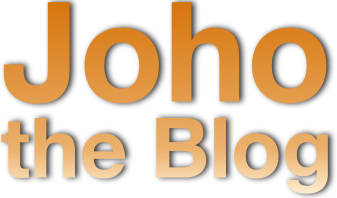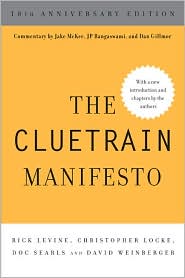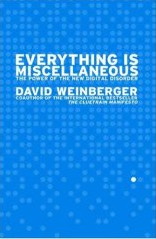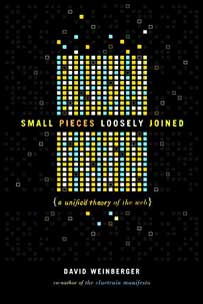March 18, 2005
[etech] My birds of a feather on taxonomy and tags
One last report on etech. I led a “birds of a feather” discussion on Tuesday night, a circle-the-chairs sort of thing for thirty people. The topic was “From Trees to Tags,” and I began with about 12 minutes on the topic. This is from the speaking notes I took into the session, so what follows is highly approximate. It’s also highly redundant with other blog posts of mine:
I’m writing a book called “Everything Is Miscellaneous,” so I convened this BoF selflishly, in order to use you and what you know.
One way of getting at what the book is about is to ask: Why is knowledge organized the way the real world is? It’s not at all obvious that we should organize our ideas the way we organize our socks.
We’ve organized knowledge into trees, from Aristotle to Linnaeus to Dewey. You get a tree by doing the basic thing of lumping and splitting, and then splitting the lumps until you get to a lump that is too unitary or miscellaneous to bear any more splitting. But lumping and splitting has been constrained by physical limitations. For example:
1. A thing has to go in one pile or another. For Aristotle, this was expressed as the Law of Identity (A is A and A is not not-A), a pretty basic rule.
2. The way we lump and split is the same for everyone: If you own a clothing store and separate it into men’s and women’s departments, it’s separated that way for everyone who enters.
3. The lumping and splitting is done by experts.
4. The person who owns the stuff also owns the organization of the stuff. You can’t come into the clothing store and rearrange it the way that suits you.
5. Lumping and splitting results in a neat and clean order. It’s clean-edged.
But now we’re digitizing information, resulting in a third order of order in which we break the rules of real-world order:
1. Things can go in more than one pile – You put your e-store’s hiking boots under shoes, men’s and women’s apparel, outdoor wear, popular items, items on sale, etc.
2. The arrangement can be different for each person.
3. You or your social group are the experts.
4. Users get to control the organization of the stuff.
5. Messiness is a virtue on the Web.
You can see much of this in the rise of tagging: Users create the metadata and anyone can figure out how to sort through it and organize it. It’s out of the hands of the owners of the stuff being classified.
So, what I’m saying is that we’re moving from thinking that the right way to arrange — and understand — things is to figure out the taxonomic tree ahead of time. Instead, make a big pile of leaves, each with lots of metadata, and allow users to add more metadata and to sort and categorize it as they need.
But there are problems with this, especially with regard to tags:
– One word can have many meanings, and one meaning can have many words. As tagging gets more popular, that’ll be a bigger issue.
– If we form social groups based around how we use words, we run the risk of fragmenting ourselves further, this time around semantics.
– Folksonomies can reinforce homogeneity.
But, I’m hopeful. Ask why tagging is happening now. After all, we’ve been able to tag Word documents forever, but we don’t. Why now? I think in part it’s because we are tagging not just for ourselves. We’re doing it socially, aware that we’re making the Web better for others. Together we’re building a new infrastructure of meaning, created by and for one another. We will figure out amazing things to do with this new social semantic construct.
(Unfortunately, I didn’t take notes during the discussion. Drat!) [Technorati tags: tags etech taxonomy]








